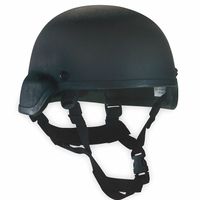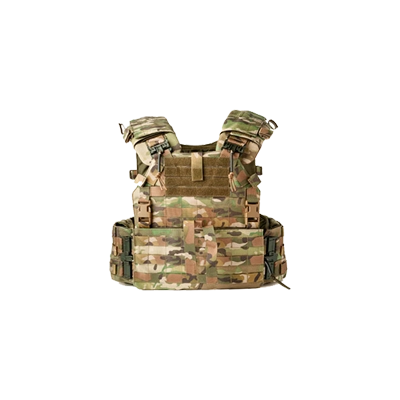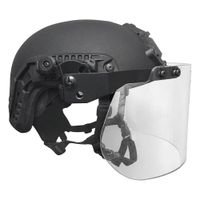Call +(254) 703 030 000 / 751 483 999 / 721 704 777
- Home
- Security
- Military Tactical Public Security Equipment
- Clothing Protective Equipment For Military Ems Law Enforcement
- Riot Gear Ballistic Protection
.....Read More
Frequently Asked Questions
What is the difference between riot gear and ballistic protection?
Riot gear and ballistic protection serve different purposes in law enforcement and military contexts.
Riot gear is designed to protect individuals from physical threats encountered during civil disturbances, such as protests or riots. It typically includes helmets with visors, body armor, shields, gloves, and shin guards. The primary focus is on safeguarding against blunt force trauma, thrown objects, and melee attacks. Riot gear is often made from materials like polycarbonate and Kevlar, providing flexibility and mobility while offering protection against non-lethal threats.
Ballistic protection, on the other hand, is specifically designed to protect against firearms and explosive devices. It includes bulletproof vests, helmets, and ballistic shields. These items are constructed from advanced materials like Kevlar, Dyneema, or ceramic plates, capable of stopping or reducing the impact of bullets and shrapnel. Ballistic protection is rated based on its ability to withstand different calibers of ammunition, with higher levels offering greater protection but often at the cost of increased weight and reduced mobility.
In summary, riot gear is optimized for defense against non-lethal threats in crowd control situations, prioritizing mobility and protection from physical impacts. Ballistic protection is focused on defending against lethal threats from firearms and explosives, emphasizing stopping power and resistance to penetration.
How effective are ballistic helmets in protecting against head injuries?
Ballistic helmets are designed to protect against head injuries by providing a barrier against shrapnel, bullets, and blunt force trauma. They are typically made from materials like Kevlar, aramid fibers, or ultra-high-molecular-weight polyethylene, which offer high tensile strength and impact resistance. The effectiveness of ballistic helmets can be assessed in several ways:
1. **Ballistic Protection**: These helmets are rated to stop certain calibers of bullets and shrapnel. For instance, a helmet rated at NIJ Level IIIA can stop most handgun rounds, including 9mm and .44 Magnum. However, they are not designed to stop rifle rounds, which require higher levels of protection.
2. **Blunt Impact Protection**: Ballistic helmets also provide protection against blunt force trauma, which can occur from falls, collisions, or blasts. The padding inside the helmet helps absorb and distribute the force of impacts, reducing the risk of concussions and other head injuries.
3. **Fragmentation Protection**: In combat scenarios, shrapnel from explosions poses a significant threat. Ballistic helmets are effective in protecting against these high-velocity fragments, which can cause severe injuries.
4. **Coverage and Fit**: The effectiveness of a helmet also depends on its coverage and fit. A well-fitted helmet that covers critical areas of the head offers better protection. Modern designs often include adjustable suspension systems to ensure a snug fit.
5. **Additional Features**: Many helmets now come with mounts for night vision devices, communication systems, and other accessories, enhancing operational effectiveness without compromising protection.
Overall, while ballistic helmets significantly reduce the risk of head injuries in combat and tactical situations, they are not foolproof. Their effectiveness is limited by the level of ballistic protection they offer and the nature of the threat encountered.
What materials are used in body armor plates for maximum protection?
Body armor plates are designed to provide maximum protection against ballistic threats and are typically made from a combination of materials to balance protection, weight, and cost. The primary materials used include:
1. **Ceramic**: Often made from alumina, silicon carbide, or boron carbide, ceramic plates are highly effective at stopping high-velocity projectiles. They work by shattering upon impact, which disperses the energy of the bullet and reduces its penetration capability. Ceramic plates are usually combined with a backing material to absorb the remaining energy.
2. **Polyethylene**: Ultra-high-molecular-weight polyethylene (UHMWPE) is a lightweight, high-strength plastic that can stop bullets by deforming and absorbing their energy. It is often used in conjunction with other materials to enhance protection while keeping the armor lightweight.
3. **Steel**: Steel plates, typically made from hardened ballistic steel, offer robust protection and are highly durable. However, they are heavier than other materials, which can limit mobility and comfort. Steel plates are often coated with anti-spall coatings to prevent fragmentation upon impact.
4. **Aramid Fibers**: Materials like Kevlar and Twaron are used in soft body armor and as backing materials for hard plates. These fibers are woven into fabric layers that can catch and deform bullets, reducing their velocity and preventing penetration.
5. **Composite Materials**: These are combinations of the above materials, designed to optimize the strengths of each. For example, a ceramic strike face might be backed by layers of polyethylene or aramid fibers to provide a balance of protection, weight, and flexibility.
The choice of materials depends on the specific threat level, weight considerations, and cost constraints, with higher protection levels typically requiring a combination of these advanced materials.
How do riot shields differ from ballistic shields?
Riot shields and ballistic shields serve different purposes and are constructed accordingly.
Riot shields are primarily designed for crowd control and protection against non-lethal threats. They are typically made from transparent polycarbonate or similar materials, allowing the user to maintain visibility while being protected. These shields are lightweight, making them easy to maneuver during dynamic situations. Riot shields are effective against thrown objects, blunt force, and low-velocity projectiles like rocks or bottles. They often feature a curved design to deflect objects and may include handles and straps for secure handling. Riot shields are commonly used by law enforcement during protests, riots, or any situation involving large crowds.
Ballistic shields, on the other hand, are designed to provide protection against firearms. They are constructed from materials like Kevlar, ceramic, or polyethylene, which are capable of stopping bullets. Ballistic shields are significantly heavier than riot shields due to the materials required to provide ballistic protection. They often include features like viewport windows, lighting systems, and weapon rests to aid in tactical operations. Ballistic shields are used in high-risk situations, such as active shooter scenarios or military operations, where there is a threat of gunfire. They are designed to stop specific calibers of bullets, and their effectiveness is rated according to standards like the NIJ (National Institute of Justice) levels.
In summary, riot shields are for non-lethal threats and crowd control, while ballistic shields are for protection against firearms, with each type tailored to its specific operational requirements.
What are the key features to look for in a plate carrier vest?
When selecting a plate carrier vest, consider the following key features:
1. **Material and Durability**: Look for high-quality materials like 500D or 1000D Cordura nylon, which offer durability and resistance to wear and tear.
2. **Weight**: Choose a lightweight design to ensure mobility and comfort, especially for extended wear.
3. **Fit and Adjustability**: Ensure the vest has adjustable shoulder straps and cummerbunds for a snug fit, accommodating different body sizes and shapes.
4. **Plate Compatibility**: Verify that the vest is compatible with the size and type of ballistic plates you intend to use, such as SAPI, ESAPI, or other standard sizes.
5. **MOLLE/PALS Webbing**: Opt for vests with ample MOLLE (Modular Lightweight Load-carrying Equipment) or PALS (Pouch Attachment Ladder System) webbing for attaching pouches and accessories.
6. **Comfort and Padding**: Look for padded shoulder straps and interior mesh lining to enhance comfort and breathability.
7. **Quick-Release Mechanism**: Consider vests with a quick-release system for rapid removal in emergencies.
8. **Load Distribution**: Ensure the vest distributes weight evenly to prevent fatigue and discomfort.
9. **Hydration Compatibility**: Some vests offer compartments or attachments for hydration bladders, which are useful for staying hydrated during long missions.
10. **Camouflage and Color Options**: Choose a color or pattern that suits your operational environment, such as multicam, coyote brown, or black.
11. **Brand Reputation and Reviews**: Research brands known for quality and reliability, and read user reviews for real-world performance insights.
12. **Price and Warranty**: Balance cost with features and check for warranties that offer protection against defects.
These features collectively ensure functionality, comfort, and protection, making them essential considerations when choosing a plate carrier vest.
How do law enforcement and military personnel choose the right size and fit for riot gear?
Law enforcement and military personnel choose the right size and fit for riot gear through a combination of standardized sizing, individual measurements, and practical testing. First, manufacturers provide sizing charts that correlate body measurements with gear sizes. Personnel are typically measured for chest, waist, hips, inseam, and height to determine the appropriate size.
Next, personnel try on the gear to ensure a proper fit. This involves checking that the gear allows for full range of motion, does not restrict movement, and provides adequate protection. Key areas of focus include ensuring that helmets fit snugly without causing discomfort, vests cover vital areas without impeding mobility, and shields are manageable in terms of weight and size.
Adjustability is another critical factor. Many pieces of riot gear, such as vests and helmets, come with adjustable straps and padding to accommodate different body shapes and sizes. This adjustability helps achieve a more customized fit, enhancing comfort and effectiveness.
Field testing is also essential. Personnel often wear the gear during training exercises to assess its performance in simulated riot conditions. This helps identify any issues with fit or comfort that might not be apparent in a static fitting session.
Finally, feedback from personnel is crucial. Their experiences and suggestions can lead to modifications in gear design or the selection of different sizes to better meet operational needs. This iterative process ensures that the gear not only fits well but also performs effectively in real-world scenarios.
What are the maintenance and care requirements for ballistic protection products?
Ballistic protection products, such as body armor and helmets, require specific maintenance and care to ensure their effectiveness and longevity. Here are the key requirements:
1. **Inspection**: Regularly inspect the ballistic panels and outer carriers for any signs of damage, such as cuts, tears, or abrasions. Check for any deformities or unusual wear that might compromise protection.
2. **Cleaning**: Clean the outer carrier according to the manufacturer's instructions, typically using mild soap and water. Avoid submerging ballistic panels in water; instead, wipe them with a damp cloth. Do not use bleach or harsh chemicals.
3. **Storage**: Store ballistic products in a cool, dry place away from direct sunlight and extreme temperatures. Avoid placing heavy objects on top of them to prevent deformation.
4. **Handling**: Handle with care to avoid dropping or bending the ballistic panels, as this can cause damage. Ensure that the armor is properly fitted and adjusted to the wearer.
5. **Replacement**: Follow the manufacturer's guidelines for the lifespan of the product. Most ballistic protection products have a recommended service life, often around 5 years, after which they should be replaced.
6. **Avoiding Contaminants**: Keep ballistic products away from oils, solvents, and other chemicals that could degrade the materials. If contamination occurs, clean immediately following the manufacturer's instructions.
7. **Documentation**: Maintain records of inspections, cleaning, and any incidents that may affect the integrity of the ballistic protection.
8. **Training**: Ensure that users are trained in the proper use, care, and limitations of the ballistic protection products.
By adhering to these maintenance and care requirements, the effectiveness and safety of ballistic protection products can be maximized, ensuring they perform as intended when needed.




